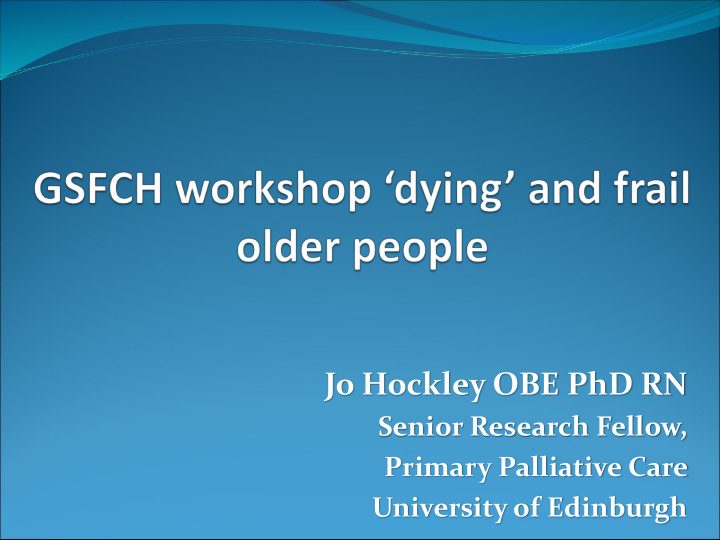



Jo Hockley OBE PhD RN Senior Research Fellow, Primary Palliative Care University of Edinburgh
▪ The visible process of dying ▪ Recognising dying ▪ Peripheral shutdown ▪ Central shutdown ▪ The invisible process of dying ▪ Exiting the body ▪ Panorama of life ▪ Expansion of self
VISIBLE PROCESS: How do we recognise dying? What is important at this stage?
• I mportance of recognising dying if we are going to manage the last days of a person’s life – Spending more of the day asleep rather than awake – No longer interested in eating – Drinking insufficient amounts – There is multidisciplinary/family agreement that further investigations and treatment is futile – In the opinion of the caring team the person is believed to be dying – The person themselves may tell you they are dying
Mouth care is of utmost importance – as long as the person can swallow – give small amounts of water – As death approaches increasing frequency BUT smaller amounts – Piece of damp gauze in mouth with crushed ice – water evaporates without risk of choking. Patient must be on their side [NB – do not use lemon/glycerine swabs] – Vaseline to lips • Regular turning – To counteract ‘stiffness’ • Importance of ‘being with’ & explaining what is going on to both the person and family/friends
“Dignity in dying is.....dying without a frantic technical fuss and bother to squeeze out a few more moments or hours of biological life, when the important thing is to live out one’s last moments as fully, consciously and courageously as possible” [David Roy, Ethics & Aging . 1988]
How do we recognise peripheral shutdown? What is important at this stage?
Person may have day/s to live • Pinched nose • ‘Death rattle’ – inability to cough up tracheal secretions • Laboured breathing – gently raise on soft pillows • Bluish and cold extremities / mottling – Don’t feel cold – restlessness often caused by heat
• Assess and manage any symptoms • Importance of a FAN • Keep a LIGHT on in the room • As sight and hearing fail – the dying only see what is near & hear what is spoken almost in their ears. – Keep outside noise to a minimum – Play soothing music
• OLDER PEOPLE – different to that of cancer-model – Anxiolytics • Diazepam supps/sol 5- 10mg ‘ prn /8hrly’ • s/c Midazolam 5- 10mg ‘ prn /4hrly’ • s/c Levomepromazine 12.5mg ‘ prn /8hrly’ – Analgesics • Paracetamol suppositories (for terminal pryrexia) • Analgesic ‘patches’ – TRANSTEC, FENTANYL (low dose) • s/c morphine 2.5- 5mg ‘ prn /6hrly’ – Anticholinergic • s/c Hyoscine 0.4mg ‘ prn /6hrly’ • s/c Glycopyrronium Kinley, Stone & Hockley (2013) Anticipatory end-of-life care medication for the symptoms of terminal restlessness, pain & excessive secretions in frail older people in care homes. End of Life Journal, Vol 3(3): 1-6
What happens an hour or so before someone dies?
▪ Thin and thready pulse ▪ Breathing becomes ‘shallow’
“Even when only watchful waiting is needed, the physician [nurse] must not underrate the help that his mere presence may afford in steadying and comforting both the dying patient and the family. When apparently doing nothing, he yet may be doing much: They also serve who only stand and wait ” [Worcester 1940]
INVISIBLE PROCESS What prevents us from recognising it?
‘A Day in the Life of Oscar the Cat’ – New England Journal of Medicine [2007]
‘Medicalisation of dying’ + taboo of death ….causes people to block engaging with the ‘instinct of dying’ in humanity
Illustrating three aspects of the invisible process of dying o The escape/exit of the self o The account rendered by self o The expansion of self [Hampe, 1970]
Recommend
More recommend